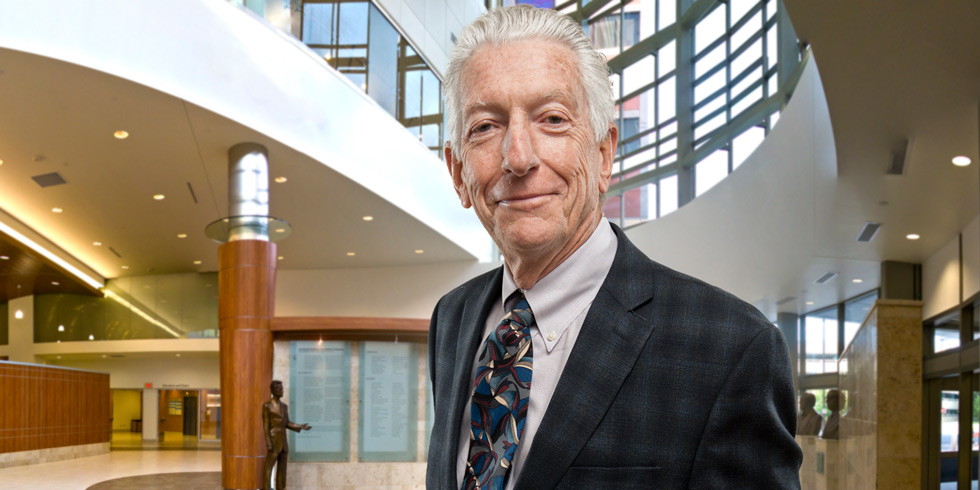
Paul Armstrong, professor of cardiology and director of the Canadian VIGOUR Centre.
Paul Armstrong has always found quiet satisfaction knowing his life's work has made a difference in the world. Armstrong, a professor of cardiology at the University of Alberta and director of the Canadian VIGOUR Centre, has won awards and acclaim for his more than 35 years of service in the field of cardiology, but his greatest pride has always come from serving his fellow man. It's why his thoughts go to his patients upon learning of the success of a lifesaving program built upon the work he and others began more than 15 years ago.
"We do health research to discover better ways of caring for our patients," says Armstrong. "It doesn't always work out, but when it does-and the result changes the way health professionals think and act-it is very gratifying."
The Vital Heart Response program emerging from this research and developed and led by Robert Welsh, a professor of medicine at the University's Faculty of Medicine & Dentistry, is operated in concert with a team of physicians, nurse and paramedics in Alberta Health Services. Since first being introduced in 2006, the program has been met with widespread acclaim. It aims to abort early-stage heart attacks during a patient's ambulance ride to hospital and came about after Armstrong's and Welsh's early research efforts more than 15 years ago, which demonstrated how pre-hospital care and treatment could speed up lifesaving interventions for heart attacks and prevent heart muscle damage in some patients.
Until recently, the widely accepted findings though have had limited real-world data to authoritatively demonstrate their effectiveness. That has since changed with the publication of new research in the Canadian Journal of Cardiology, examining the impact of the Vital Heart Response program on 2,335 heart attack patients from the greater Edmonton region.
"Our research shows it's possible to avoid a major heart attack with really no heart muscle damage in patients who present early with symptoms and are treated early with effective therapies in the ambulance prior to arrival at the hospital," says Kevin Bainey, one of the study's authors and an assistant professor in the Department of Medicine at the U of A.
"In fact, if you receive fibrinolysis (a clot-busting drug) within the first hour of symptoms, you have roughly a 30 per cent chance of aborting a heart attack with minimal, if any, heart muscle damage-far superior outcomes compared to those who didn't abort their heart attack," says Bainey.
The University Hospital Foundation funded study-led by researchers at the University of Alberta's Faculty of Medicine & Dentistry, the Mazankowski Alberta Heart Institute and the CK Hui Heart Centre-highlights the life-saving benefits of the Vital Heart Response system, which serves Edmonton and all of northern Alberta to expedite diagnosis and treatment for patients en route to major cardiac facilities
Bainey says the program can be partly credited for Alberta's heart attack mortality rate being more than two per cent below the national average, at 4.9 per cent. It's a sentiment those tasked with overseeing the province's health system can agree.
"The Vital Heart Response system is one example of how made-in-Alberta innovations are saving the lives of Albertans and making the province a global leader in the area of cardiac care," says Stephen Mandel, minister of health. "I applaud everyone involved in developing and implementing this life-saving system."
Unique in Canada, the Vital Heart Response system requires co-operation between different parts of the health system. Heart specialists in Edmonton take calls from the ambulance and small community hospitals to co-ordinate care for patients who suffer life-threatening STEMI
(ST Elevation Myocardial Infarction) heart attacks, which occur when a blood clot completely blocks the coronary artery, causing the heart muscle supplied by that artery to die.
When a patient presents with chest pains, for example, cardiologists and EMS work in tandem to diagnose the issue while the patient is still in the ambulance, and decide whether to inject a clot buster on the spot or to mobilize a hospital team to perform an emergency procedure (such as angioplasty to clear the artery and restore blood flow) upon the patient's arrival at hospital.
Bainey's study co-authors include Robert Welsh, who is the founder and co-chair of the Vital Heart Response program.
"Understanding the complexity of disease and developing solutions to improve patient care requires collaboration and insight from many disciplines," says David Evans, vice-dean of research at the Faculty of Medicine & Dentistry. "Drs. Welsh and Bainey have taken landmark discoveries made in Edmonton and ensured Albertans are receiving the best quality of care."
It is care that Armstrong takes pleasure in, knowing he and Welsh played an initial role. Still, he says despite gains in patient health there's much more to be done. He for one can't wait to start.
"[The program's success] provides the impetus to keep on working!"